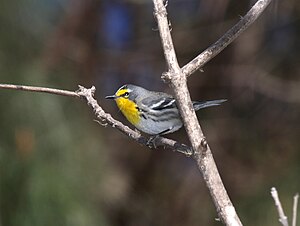Arizona Warbler
| Arizona Warbler | ||||||||||||
|---|---|---|---|---|---|---|---|---|---|---|---|---|

Arizona Warbler ( Setophaga graciae ) |
||||||||||||
| Systematics | ||||||||||||
|
||||||||||||
| Scientific name | ||||||||||||
| Setophaga graciae | ||||||||||||
| ( SF Baird , 1865) |
The Arizona warbler ( Setophaga graciae , Syn . : Dendroica graciae ) is a small bird in the warbler family. It was discovered in the Rocky Mountains in 1864 by the historian , ornithologist and author Samuel Elliott Coues . Coues chose the English name "Grace's Warbler" after his sister Grace Darling Coues. In 1865, Spencer Fullerton Baird described the bird scientifically and kept the name.
Arizona warblers have a body length of about eleven to thirteen centimeters. The upper side plumage is gray in color with black stripes and two white wing rods on the wing covers. The underside plumage is white with a yellow throat and chest plumage. There are black stripes on the flanks.
Like most warbler species, the Arizona warbler feeds primarily on insects .
Arizona warblers inhabit open mixed pine forests in the mountains of western and southwestern North America and northern Mexico during the breeding season . Over the winter they migrate to Central America like Nicaragua .
literature
- Jon Curson, David Quinn, David Beadle: New World Warblers. Helm, London 1994, ISBN 0-7136-3932-6 .
Web links
- Setophaga graciae in the Red List of Threatened Species of the IUCN 2008. Posted by: BirdLife International, 2008. Accessed on December 20 of 2008.